Back to Our Future (B2OF)
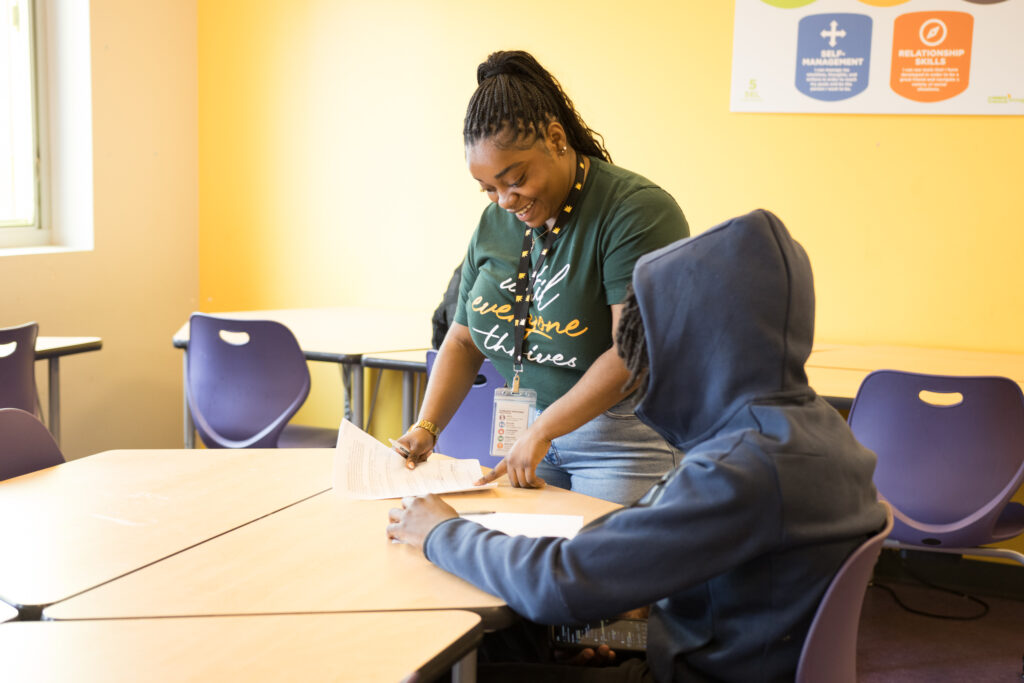
Back to Our Future (B2OF) is a state-funded, district-led, evidence-informed effort to re-engage disconnected students at an elevated risk for gun violence involvement.
Challenge
Not completing high school increases young people’s likelihood of becoming involved in gun violence. In Chicago, the connection between disengagement from school and gun violence is clear: Analysis from the Crime Lab and Education Lab shows that as of March 2023, more than 90% of school-aged victims of gun violence were inactive at the time of their victimization. Existing violence prevention programs for youth have focused on those who still have some connection to school. Consequently, young people disconnected from school have historically been out of reach of crucial services and support.
Opportunity
In May 2022, Illinois Governor J.B. Pritzker and the City of Chicago Mayor’s Office announced an $18 million investment to support the B2OF pilot program, aiming to re-engage 1,000 disconnected young people in school. To implement B2OF, CPS partners with three community-based organizations: Breakthrough, UCAN, and Youth Advocate Programs (YAP), Inc.
The Plan
To support this ambitious effort, the Crime Lab partnered with CPS throughout the pilot year of B2OF, which concluded in May 2023. In addition to analyzing referral, consent, and participation data, the Crime Lab provided implementation support to UCAN, YAP, and Breakthrough staff and conducted focus groups to understand how youth experienced the program.
Project overview
The primary goal of B2OF is to provide eligible youth with intensive support to reduce the likelihood that they will be involved in gun violence and increase the likelihood that they will re-engage with school. B2OF focuses on reaching young people aged 14-21 in 15 community areas on the South and West Sides of Chicago who have been disconnected from school for at least a year and are at high risk of being involved with gun violence.
Eligible participants are identified through one of four pathways:
- Partner referrals from community organizations
- Institutional referrals from city agencies and other institutions such as Cook County Juvenile Probation, Cook County State’s Attorney’s Office
- Community-based organization (CBO) reverse referrals from internal staff
- Data driven referrals that leverage administrative data from CPS to identify youth who may be likely to engage in gun violence and be inactive in school
Program Services
Upon choosing to participate in B2OF, youth receive 12 months of programming that begins with a 12-week period of paid, intensive services in soft skills training, community building, mental health interventions, including trauma-informed cognitive behavioral interventions (CBI), mentorship and family supports, and academic credit recovery.
As a part of the program, youth create a plan to return to an education program that best meets their post-secondary goals and individualized needs. Education pathways include enrolling in a CPS traditional high school, enrolling in a CPS Options school, or enrolling in a General Educational Development (GED) program through Chicago City Colleges.
Read more about the first year of implementation below.
Years Active
2022 – 2024
Topics
Project Leads
Brenda Benitez
Senior Implementation Manager

Heather Bland
Research Manager

Salman Khan
Research Director

Kim Smith
Director of National Programs and External Engagement

Ilana Walden
Founder and CEO, Forest Zafran Consulting LLC

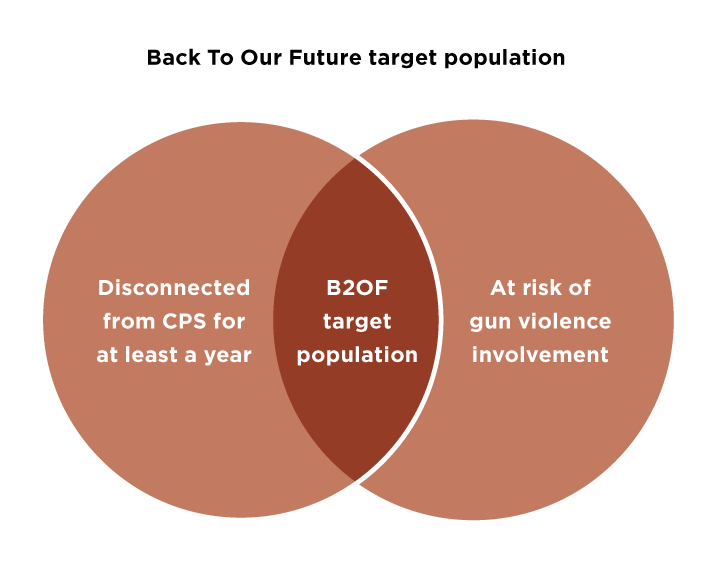
Once participants complete the 12-week intensive programming, B2OF aims to provide individualized follow-up services and mentorship to help stabilize newly re-enrolled participants within their education completion pathway. After 12 months of B2OF programming, youth receive light-touch, ongoing support services and case management to guide them to high school graduation or completion and successful transition into their chosen post-secondary pathway.
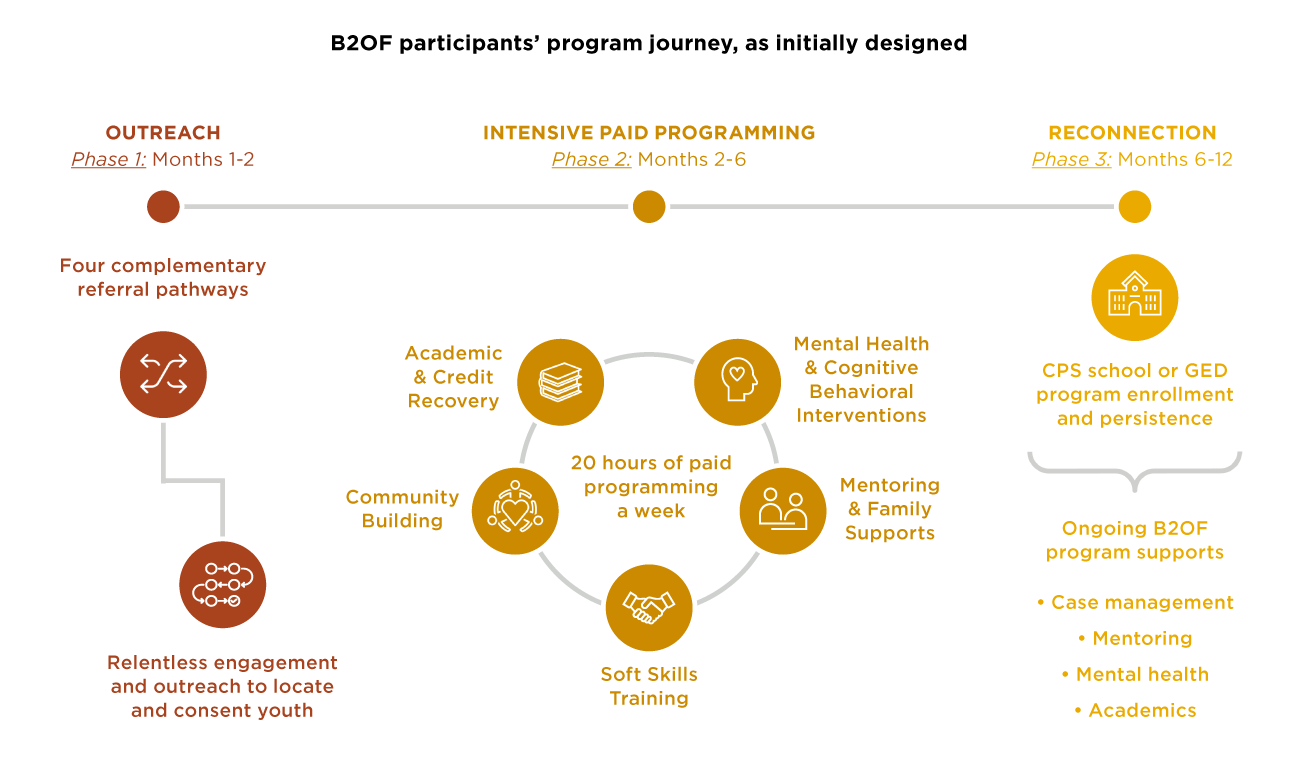
Findings
Identifying Youth
The use of multiple referral pathways helped identify more youth for B2OF eligibility by providing greater coverage for CPS to identify potential participants compared to a single referral source. The majority of referrals (79%) were CPS data driven referrals, followed by CBO reverse referrals (12%), partner referrals (6%), and institutional referrals (3%).
Based on demographic characteristics prior to referral, youth referred to B2OF partners meet the stated eligibility criteria. The vast majority (87%) of referrals were inactive in school at the time of referral, and almost half (41%) had been inactive for longer than 18 months. Among referred youth, 46% had been previously arrested, and 23% had specialized education needs. The average young person referred to B2OF was 19 years old, and roughly two-thirds were Black. These characteristics are mostly aligned with the referral criteria outlined in the program design, indicating that the referral pathways can effectively identify youth in the target population for B2OF.
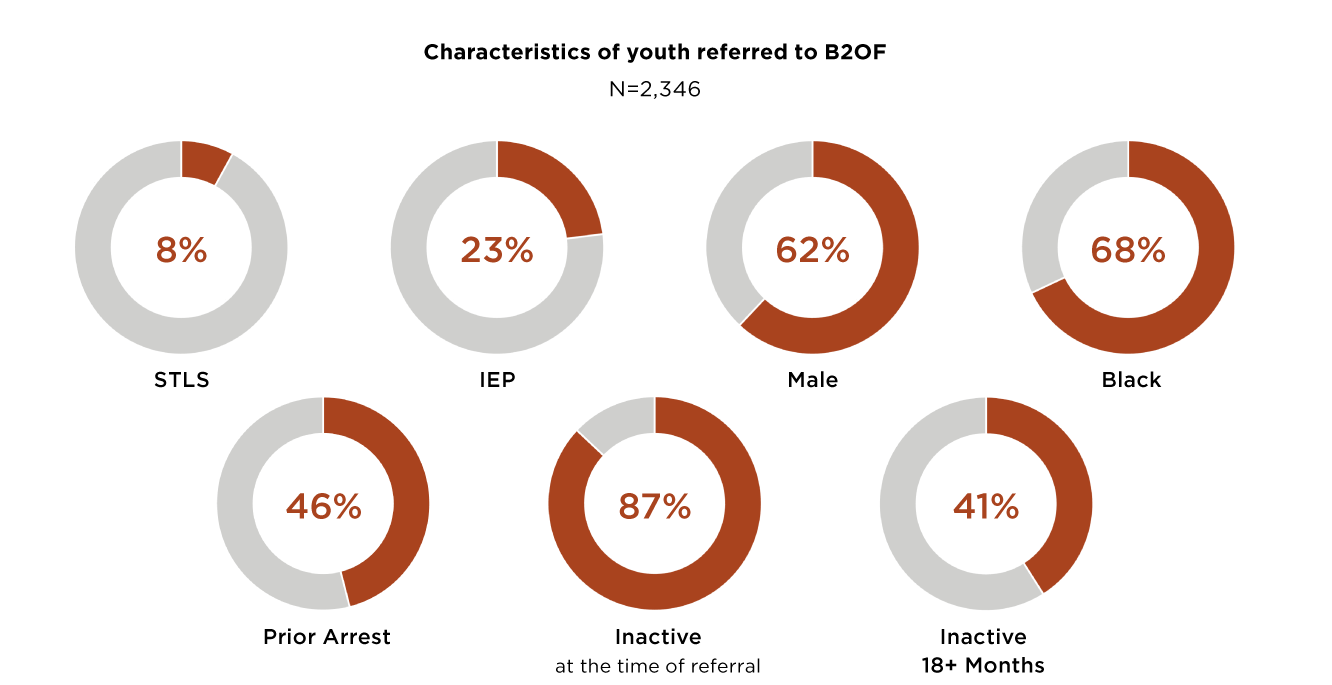
Engaging Youth
The overall consent rate for the program across the four referral pathways is 19%, which suggests about 1 in 5 referred youth are consenting to participate. The consent rate varied greatly depending on the referral pathway. Data driven referrals had the lowest consent rate at around 5%, meaning only 1 in 20 referred youth consented to programming. On the other hand, roughly 9 out of every 10 CBO reverse referrals led to youth consenting to participate in B2OF. Partner and institutional referrals saw similar rates to each other, with around half of referred youth consenting to programming. Despite data driven referrals being the pathway most likely to refer eligible students, their low consent rate means that CBO referrals bring almost three times as many youth to the program.
These patterns suggest that relationships and touchpoints between referred youth and service providers are likely important factors for youth when deciding whether to participate in the program.
Youth Experience
We found that B2OF participants attended, on average, nearly seven hours of programming per week, which is less than 50% of the 20 hours set as the program target. However, the average participation in services increased over time to about nine hours as of May 2023. Across the five service areas (mentoring, community building, academic and credit recovery, mental health, and soft skills), we saw considerable variation in actual versus target hours. Specifically, we observe that the average B2OF participant received low dosage in academic credit and recovery (0.8 received of 3-hour target) and mental health (0.5 received of 3-hour target) programming.
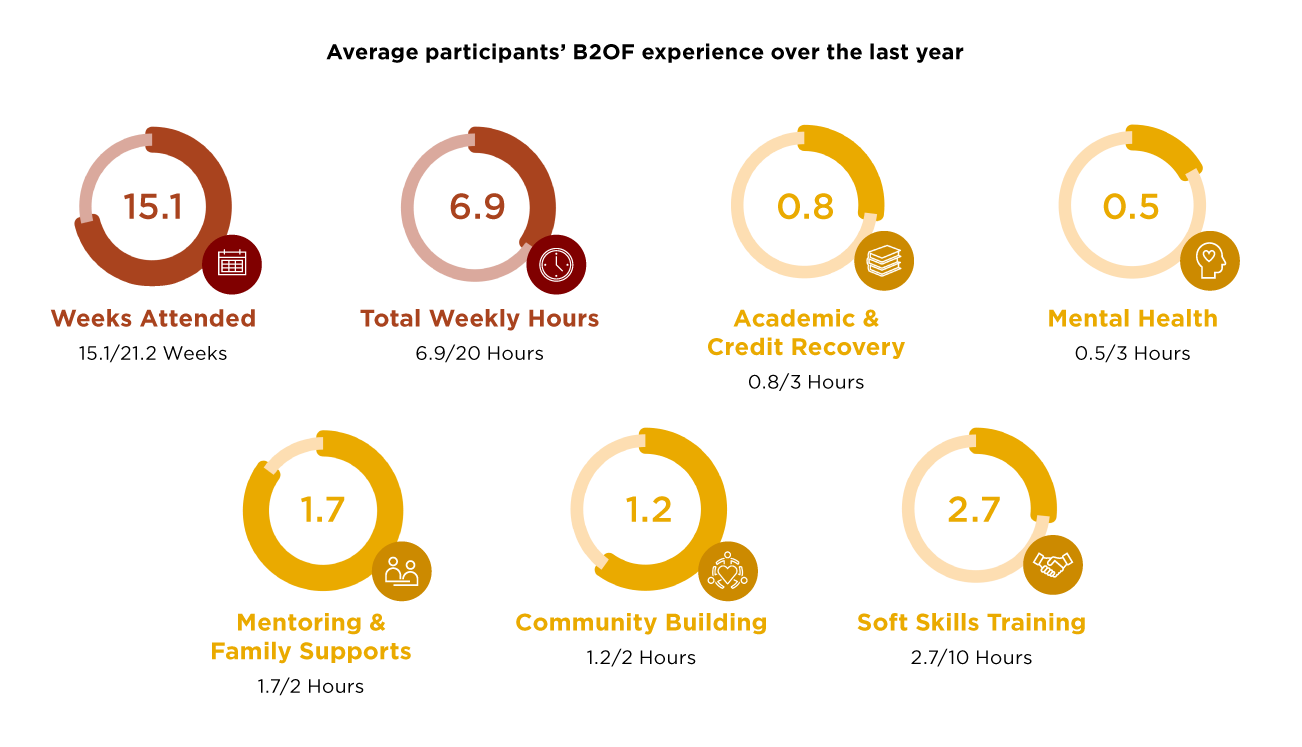
B2OF offers an unprecedented opportunity to address the decades of underinvestment in Black and Brown communities, which has led to the program’s target population facing significant barriers to high school graduation, post-secondary success, and safety. While we have made significant strides in the first year of implementation, much work remains to better engage and serve the young people currently underserved by existing systems. Overcoming these barriers to successful implementation requires creativity, a deep understanding of youth experiences, and a commitment among all partners to continuous improvement.
Latest Updates
How many out-of-school, out-of-work youth did Chicago reengage last school year?
Chalkbeat covers the ‘Crime Labs’ evaluation of Back to Our Future, a Chicago Public Schools initiative providing support services for disengaged youth to get them reconnected and back on track to complete their education.
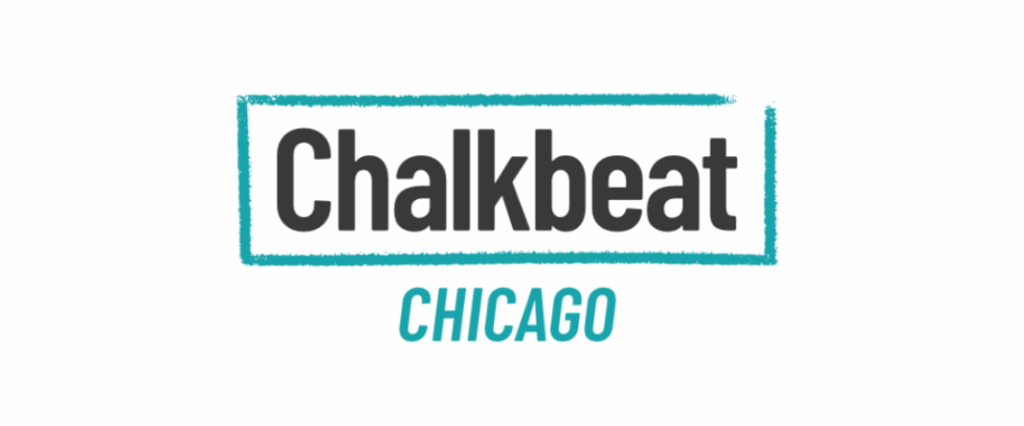
Expensive effort to get high-risk kids back in school is off to a slow start
Read about the ‘Crime Labs’ work to help shape a Chicago Public Schools program working to reengage disconnected youth.
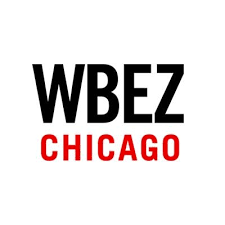
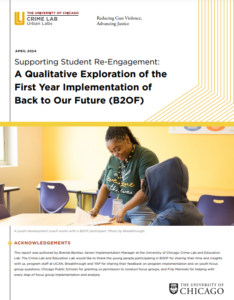
Supporting Student Re-Engagement: A Qualitative Exploration of the First Year Implementation of Back to Our Future
This report shares findings on the implementation of Back to Our Future, a state-funded, district-led, evidence-informed effort to re-engage disconnected students at an elevated risk for gun violence involvement.
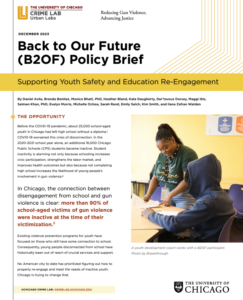
B2OF Policy Brief: Supporting Youth Safety and Education Re-Engagement
This policy brief outlines the first year of implementation of Back to Our Future (B2OF), a state-funded, district-led, evidence-informed effort to re-engage disconnected students at an elevated risk for gun violence involvement.
Abdul Latif Jameel Poverty Action Lab (J-PAL) Youth Summer Employment Report
An analysis of the effectiveness of youth summer employment with a reduction in youth involvement in violent crime.
Bolstering Belonging in BAM and Beyond
Read more about the qualitative evaluation of Youth Guidance’s Becoming a Man program.
